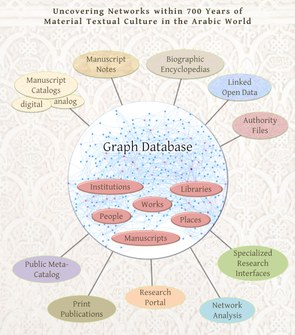On people, books and manuscript notes
“” |
Incorporating all new bio-bibliographical information in one large database would be of prime importance. It has been tried, but so far it has failed. It could never be the work of one man, but at best a dedicated institution with large and longterm funds might be able to perform that task. Jan Just Witkam “Brockelmann’s Geschichte Revisited”, in GAL, New Edition (2012) |
Taking our long-term experience with the manuscript repository MyIHS and its data model as a starting point, the project is developing a research platform (Khizana) with two objectives. First it aims to be a comprehensive bio-bibliographical reference work for Arabic manuscripts as well as for manuscript notes. Secondly, building on that wealth of collected data it also provides tools for the exploration and visualisation of social and historical contexts of the manuscripts – their production, transmission, collection, and reception.
Bio-bibliographical reference work
As a reference work, the platform integrates three different kinds of sources:
- Information from manuscript catalogues relevant to the project. This includes printed catalogues, as well as data available from manuscript databases, such as the collections at German institutions (Leipzig University Library, Berlin State Library, etc.) and others.
- Information from biographical and bibliographical reference works, such as Ḫayr ad-Dīn al-Ziriklī’s al-Aʿlām and Ḥāǧǧī Ḫalīfa’s Kašf az-zunūn. It will also integrate Open Linked data from various sources, as well as data from authority files such as the Virtual International Authority File (VIAF).
- Information contained in manuscript notes. This includes but is not limited to owners, readers, and collectors of manuscripts, and, if available, the material context, e.g., the price. These notes will be taken directly from the manuscripts in various collections around the world (see micro-perspective)
On a technical level, building the platform means integrating and processing information from very diverse sources. Special emphasis will be laid on providing evidence (i.e., provenience) for every entry. One of the main tasks will be to create thousands of authority files on persons and works, many of them not contained in the Virtual International Authority File. In this context, Digital Humanities approaches will be developed for identifying persons and works, for example, relating different variants of names and titles to a specific person or work.
Exploring and visualising the social and historical context

Based on cutting-edge graph database technologies, the platform will enable researchers to trace the historical career of a work, a person or, possibly, attributed literary elements, such as genres or topics.
The processing and presentation of information will produce visualisations of networks, such as personal and scholarly relations, as well as geographical maps showing relations between regions, wherever enough reliable data is available.
By linking data on the production, reception, and circulation of manuscript textual witnesses, the research platform will not only prove beneficial for literary history, but this completely new and unique tool of presentation and exploration will result in enormous gains to manuscript research focused on social and cultural history, which is currently on the rise.
The platform will include a bio-bibliographical reference work of Arabic authors and works, and an online database of manuscript notes, as well as a research library that will provide tools for exploring and visualising larger interrelations in the history of Arabic manuscript literatures. A first online version will be published at an early stage of the overall project (2020); work on the platform will be expanded continuously in the subsequent years.
More information
Macro-Perspective: On the production, transmission, and reception of Arabic literatures
Micro-Perspective: On the reception and collection of Arabic literatures
Are you working on people, names, manuscript meta data and their linkability?
Please feel free to get in touch with us!
Contact
Dr.Thomas Efer (efer  saw-leipzig.de) on the technical infrastructure
saw-leipzig.de) on the technical infrastructure
Dr. Daniel Kinitz (kinitz  saw-leipzig.de) on sources & data integration
saw-leipzig.de) on sources & data integration
Bibliotheca Arabica – Towards a New History of Arabic Literature
Saxon Academy of Sciences and Humanities
Karl-Tauchnitz-Str. 1
04107 Leipzig/ Germany
